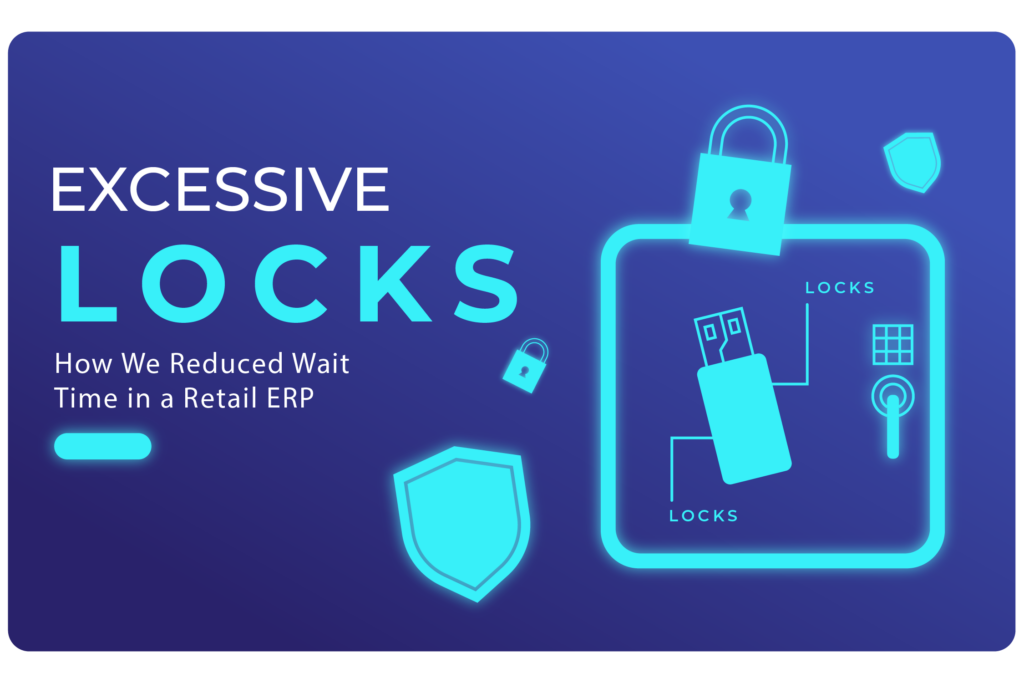

A retail ERP at the peak of Black Friday. Thousands of simultaneous customers trying to complete purchases, inventory being updated in real-time, payments processed by different gateways. The machine seems ready for the challenge, with plenty of CPU and memory. However, the system starts to struggle. Slow transactions, some customers complaining of “timeout” errors, and a growing number of paralyzed operations. The culprit? An invisible and silent problem that only reveals its impact in the hour of chaos: excessive locks on the database.
Dealing with locks is one of the biggest challenges in high-concurrency environments. They are essential security mechanisms to ensure data integrity, but when poorly managed, they turn a routine operation into a data traffic jam. The inefficiency doesn’t manifest as high CPU, but rather as extended wait times, paralyzing critical transactions and directly impacting revenue and customer experience. This article details how dbsnOOp acted in a real case to diagnose and resolve a locks problem in a retail ERP, using observability and AI to transform chaos into predictability.
What Are Locks and Why Do They Create Chaos?
At its core, a lock is a mechanism a database uses to control simultaneous access to a row or table, preventing two processes from altering the same data at the same time. It’s like a queue: one process enters, does what it needs, and leaves, allowing the next one in. The problem arises when:
- Locks Are Held for Too Long: A poorly optimized query or a long, inefficient transaction holds a lock for too long, blocking all other processes that need that same resource.
- Locks Become a Guessing Game: Two queries try to access resources in different orders. Query A needs Table X, which Query B has already locked. Meanwhile, Query B needs Table Y, which Query A has locked. The result is a deadlock, where both wait forever, forcing the database to kill one of them to resolve the impasse.
- Lack of Context: Traditional monitoring tools might show accumulated wait time, but they can’t correlate the problem with the exact query, application, user, or business flow that caused it. It’s a blind diagnosis.
In a retail ERP, where every second of latency can mean a lost sale, excessive locks are not just a technical problem—they are a business problem. They affect the ability to process orders, update inventory, and generate reports, all in real time.

dbsnOOp’s Forensic Hunt: From Chaos to Root Cause
dbsnOOp’s approach to solving the locks problem goes beyond generic alarms. It uses a combination of deep observability and intelligent analysis to conduct a true forensic investigation of the database, identifying the epicenter of the problem and its solution.
1. Granular Observability: The Monitoring That Sees the Invisible
dbsnOOp monitors every lock in real time, but with a level of detail that traditional tools don’t offer. It doesn’t just detect wait time; it maps the “lock chain”:
- Identification of the Blocker: The platform points out the exact query that is holding the lock for the longest time, as well as the transaction and user that initiated it.
- Mapping of the Blocked: It identifies all the queries in the queue, waiting for the resource, showing the cascading impact.
- Historical Analysis: dbsnOOp builds a baseline of normal lock behavior, allowing for the detection of anomalies and the triggering of alerts before the problem becomes critical.
This detailed and correlated view eliminates the need for hours of manual troubleshooting, providing the root cause in minutes.
2. Artificial Intelligence: Precise Diagnosis and Optimized Solution
Upon detecting an excessive lock or a deadlock, dbsnOOp’s AI springs into action. It correlates the collected information to deliver a precise diagnosis and, most importantly, the solution.
- Pattern Analysis: AI identifies if the problem is recurring, if it’s linked to a specific query, a new code deployment, or an unexpected traffic spike.
- Solution Suggestions: For each scenario, AI suggests a corrective action. For example, if the problem is a deadlock, AI can suggest restructuring the queries so they always access tables in the same order, eliminating the impasse. If the problem is a long-duration lock, it can propose optimizing the blocking query, such as creating an index that accelerates its execution.
- Automation and Text-to-SQL: dbsnOOp doesn’t just suggest. It generates the optimized SQL command, ready to be copied and pasted, or, with Text-to-SQL, it allows the team to describe what they need (“Create a script to reorganize the indexes of the orders table”) and AI delivers the functional code.
This capability transforms a DBA’s routine from detective work into proactive engineering.
The Real Result: The End of the Retail ERP Traffic Jam
The implementation of dbsnOOp in a major retail ERP platform brought impressive results. The technical team, previously overwhelmed with lock troubleshooting, gained total and predictive visibility into what was happening in the database.
- Reduced Wait Time: The average wait time for critical transactions dropped drastically, from minutes to milliseconds.
- Fewer Deadlocks and Timeouts: Proactive detection and optimization suggestions almost completely eliminated deadlocks and timeout errors, ensuring smooth operations.
- Consistent Performance: The system operated with high performance and stability, even during traffic spikes, such as on major promotion days.
- More Productive Team: The time spent on troubleshooting was drastically reduced, allowing the DevOps and DBA teams to dedicate themselves to strategic optimization and innovation projects.
The experience of this ERP proves that the locks problem doesn’t have to be a fatality. With the right intelligence, it’s possible to not only resolve but prevent these bottlenecks, ensuring that the database functions as the smooth, powerful engine your retail operation demands.
Want to end data traffic jams and ensure your ERP’s performance? Schedule a meeting with our specialist or watch a practical demonstration!
Schedule a demo here.
Learn more about dbsnOOp!
Learn about database monitoring with advanced tools here.
Visit our YouTube channel to learn about the platform and watch tutorials.


